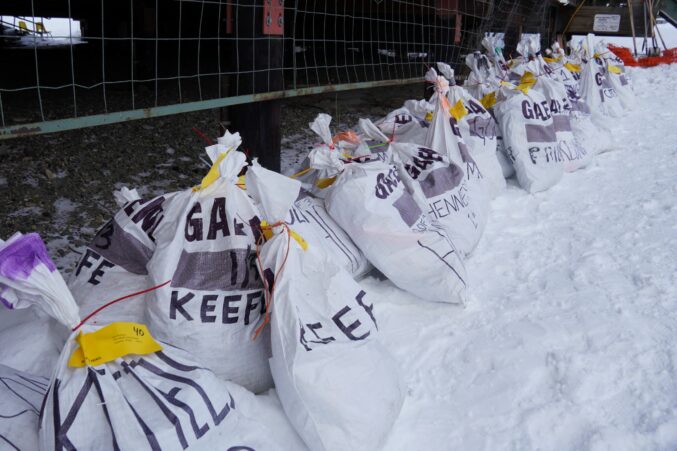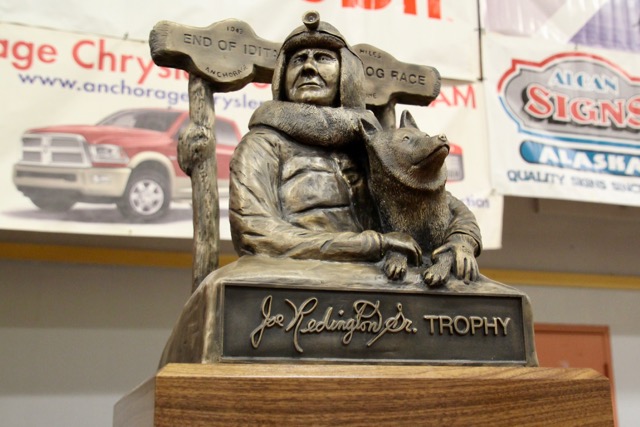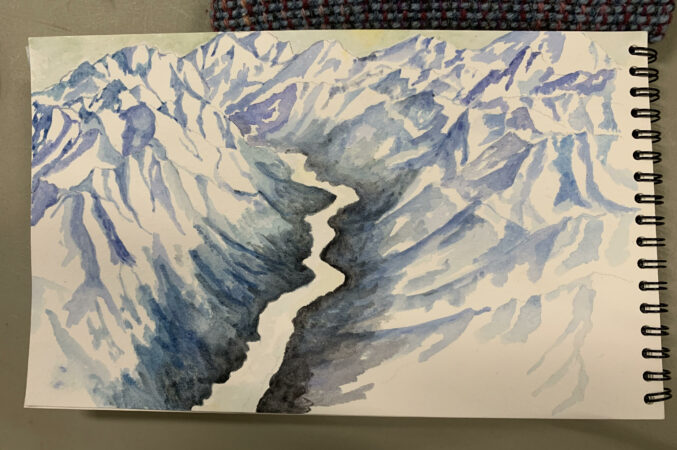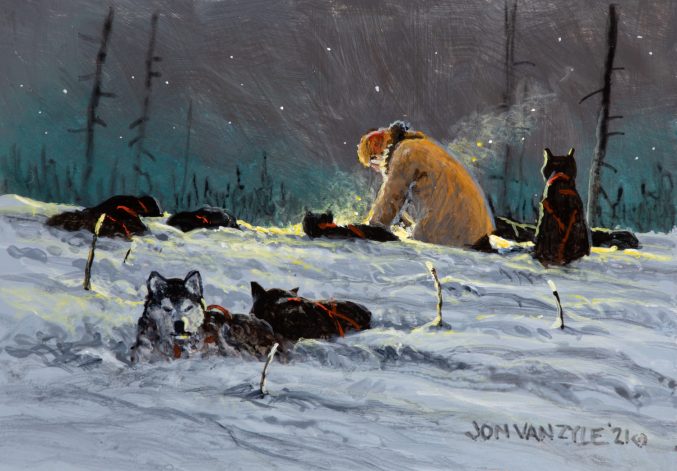The Iditarod is full of majestic, sublime moments that are worthy of a painting. Being on the ground and in the air on the trail has put me into close contact with the race, closer than I’ve ever been. Because I’ve only seen the Ceremonial Start and Restart prior to this, my immersion into the race this year has been almost overwhelming at times. I’ve cried for joy, been touched with sentiment, laughed, and felt contemplative, just like a good work of art can make you feel.

Drop bags line the side of the checkpoint cabin at Galena. Photo: K. Newmyer
One of the many things I appreciate so much about the Iditarod is the opportunity to enjoy it from an artistic perspective. I love art and the artistic process. I frequently frame certain images in my mind and take mental snapshots. The Iditarod and the Jr. Iditarod have wonderful artists and photographers. Jon van Zyle, painter, has been the official artist of the Iditarod since 1978 (after twice running the race). Jeff Schultz has been photographing the Iditarod and Alaska for more than forty years, and his images of racers, dogs, and their interactions are iconic and beautiful. Dave Poyzer and Siri Raitto contribute their artistic perspective, along with Whitney McClaren who photographs the Jr. Iditarod.
The Iditarod winner’s trophy also contains rich artistic history. The trophy was first designed by Bill Devine based on a photograph of race founder Joe Redington, Sr. with his dog, Feets. Doug Swingley was the first to receive the trophy in 2000. After Redington’s death, artist Pat Garley was commissioned to redesign the trophy for the 2016 race. The Iditarod champion trophy is a wonderful likeness and tribute to the man with the vision for preserving sled dogs and the mushing way of life, and represents a collaboration between many individuals.

The Redington Trophy. Photo: Iditarod Media
Art should be an integral part of our lives. Art has many functions: to elicit an emotional response, to persuade viewers of an idea or viewpoint, to entertain, to inform, and to simply capture beauty. Artists who create art do so for a variety of reasons, including helping them process emotional responses to events and ideas. The artists of the Iditarod help us see the race in new ways, and in turn, we can see ourselves in new ways by reflecting on the images and creating art in response to the Iditarod. I’m using my camera to try to capture scenes that speak to me. I’ve seen many photographers along the trail, beautiful written tributes to sled dogs, posters, and many other works of art. Trail volunteer Lena is creating an art journal of her time working for the Iditarod, and this is one of her images in response to the scene from the air as she traveled from Anchorage to McGrath.

Trail volunteer Lena captured a scene of the mountains while flying over the Iditarod Trail with watercolors. Photo: K. Newmyer
Whether you are an art teacher or not, consider integrating art into your Iditarod-themed lessons. According to the Kennedy Center, arts integration is “an approach to teaching in which students construct and demonstrate understanding through an art form. Students engage in a creative process which connects an art form and another subject area and meets evolving objectives in both.” Arts integration can thoroughly cement a student’s learning. This is because art creates an emotional connection to the content.
Here are some ways to integrate art into your Iditarod lessons. Instead of showing the pictures as you read aloud a sled dog book, have students draw the images in their heads. When I do this with my class, I don’t give a lot of parameters. Students are free to create a variety of images, from mural-like pictures to cartoons with multiple panels. For math lessons, show an equation and ask students to draw dog teams, mushers, and other Iditarod items to represent the calculation, assigning values to each and combining them into a cohesive image. Students can study science topics like weathering, erosion, the water cycle, climate and weather, tectonics, hydrology, and glaciology by looking for these topics in Iditarod trail descriptions, then apply what they have learned to create an illustration of that section of the trail.
In addition to visual arts, the Iditarod lends itself to musical, written, and theatrical art forms. Hobo Jim’s “Iditarod Trail Song” can be an inspiration for students to create lyrics and write music about the Iditarod. Advanced music students could compose pieces that capture the essence of different photographic images of the Iditarod. Theater is a great way to capture the great stories of the Iditarod, and don’t forget to incorporate the incredible dog personalities! Students can write, stage, direct, and act in their own Iditarod theater productions—on as large or small a scale as you wish. Writers can create fiction stories and poetry based on the Iditarod to hone their characterization, dialog, and figurative language skills.

Artwork by Jon Van Zyle — ALL RIGHTS RESERVED
Nighttime scene of a Dog team resting in the snow with a side view of the Musher man leaning over a campfire with sparks and smoke in the air and stars in the sky.
So many ways exist to integrate the arts into your Iditarod studies, or to integrate the Iditarod into your arts studies. Many of the moments I’ve experienced on the trail are worthy of a work of art. It is up to each of us how we express our admiration and appreciation for the Iditarod, the Last Great Race.
How do you integrate the arts and the Iditarod? Email me at emailtheteacher@iditarod.com.


